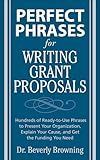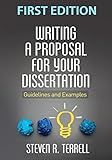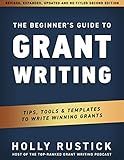Best Educational Proposal Tools to Buy in December 2025

Perfect Phrases for Writing Grant Proposals (Perfect Phrases Series)



Writing Winning Business Proposals, Third Edition



Writing a Proposal for Your Dissertation: Guidelines and Examples



Book Proposal Tips and Tricks



Handbook For Writing Proposals, Second Edition



The Beginner's Guide to Grant Writing: Tips, Tools, & Templates to Write Winning Grants


An education project proposal is a formal document that outlines a specific plan for implementing an educational initiative. It typically includes details about the objectives of the project, the target audience, the resources needed, the timeframe for implementation, and the expected outcomes. The proposal also often includes a budget breakdown and a plan for evaluation and monitoring of progress. Education project proposals are commonly used by schools, non-profit organizations, and government agencies to secure funding or approval for new education programs or initiatives. Successful proposals are clear, well-organized, and persuasive in demonstrating the need for the project and its potential impact.
How to format an education project proposal?
When formatting an education project proposal, it is important to follow a clear and organized structure to effectively communicate your ideas and plans. Here are some steps to help you format your education project proposal:
- Cover page: Include the title of your project, your name, the name of your organization, and the date.
- Table of contents: Create a table of contents to guide readers through the proposal.
- Executive summary: Provide a brief overview of the project, including the objectives, methods, and expected outcomes.
- Introduction: Introduce your project and provide background information on the issue you are addressing.
- Needs assessment: Explain the need for the project and how it will address specific challenges or gaps in education.
- Goals and objectives: Clearly state the goals and objectives of the project, outlining what you hope to achieve.
- Project description: Provide a detailed description of the project, including the activities, timeline, and resources needed.
- Budget: Break down the costs associated with the project and provide a detailed budget.
- Evaluation plan: Explain how you will measure the success of the project and evaluate its impact.
- Conclusion: Summarize the key points of the proposal and reiterate the importance of the project.
- Appendices: Include any additional information, such as supporting documents, references, or letters of support.
Make sure to use a professional and easy-to-read font, such as Times New Roman or Arial, and use headings and subheadings to organize the content. Proofread the proposal carefully to check for any spelling or grammatical errors. Additionally, consider the preferences of the organization or institution you are submitting the proposal to and tailor the format accordingly.
How to create a budget for an education project proposal?
Creating a budget for an education project proposal involves identifying all the costs associated with the project and estimating the amount of funding needed to successfully implement it. Here are some steps to help you create a budget for your education project proposal:
- Identify all the expenses: Start by listing all the expenses that will be incurred during the project, including costs for materials, equipment, staff salaries, travel, training, and any other expenses related to the project.
- Estimate the costs: Once you have identified all the expenses, estimate the cost for each item. You can do this by researching prices, obtaining quotes from vendors, or consulting with experts in the field.
- Consider all sources of funding: Determine all possible sources of funding for the project, including grants, donations, sponsorships, and in-kind contributions. It is important to consider both cash and in-kind contributions when creating the budget.
- Allocate funds wisely: Allocate the funds to each expense item based on their priority and importance to the project. Make sure to also budget for any unexpected or contingency costs that may arise during the project implementation.
- Create a budget spreadsheet: Use a spreadsheet to organize and document all the expenses and funding sources for the project. Include columns for the item description, estimated cost, actual cost, funding source, and any notes or comments related to the expenses.
- Review and finalize the budget: Review the budget carefully to ensure all expenses are accounted for and the funding sources are aligned with the project needs. Make any necessary adjustments and finalize the budget before including it in your education project proposal.
By following these steps, you can create a comprehensive budget for your education project proposal that accurately reflects the costs and funding needed to successfully implement the project. This will help you make a compelling case for funding and demonstrate that you have thoroughly thought out the financial aspects of the project.
How to structure an education project proposal?
- Introduction:
- Provide a brief overview of the project, including the goals and objectives.
- Explain the need for the project and how it will address challenges or gaps in education.
- Background:
- Provide a detailed analysis of the current education system or situation that the project aims to improve.
- Include relevant data, statistics, and research to support the need for the project.
- Project Description:
- Outline the specific activities and strategies that will be implemented to achieve the project goals.
- Specify the target audience, location, and duration of the project.
- Detail the resources, budget, and timeline required for the project.
- Expected Outcomes:
- Clearly define the expected results and impact of the project.
- Include measurable objectives and indicators to track progress and evaluate success.
- Sustainability:
- Explain how the project will be sustained beyond its initial implementation phase.
- Outline strategies for continued funding, support, and partnerships to ensure long-term impact.
- Monitoring and Evaluation:
- Describe the monitoring and evaluation framework that will be used to assess the progress and effectiveness of the project.
- Detail how data will be collected, analyzed, and used for continuous improvement.
- Budget:
- Provide a detailed budget for the project, including projected expenses and sources of funding.
- Include a justification for each budget item and explain how the funds will be managed.
- Conclusion:
- Summarize the key points of the proposal and reiterate the importance and potential impact of the project.
- Thank the reader for considering the proposal and invite any questions or feedback.
What is the criteria for selecting a funding source for an education project proposal?
- Alignment with the funding source's mission and priorities: The funding source should have a focus on education and align with the goals and objectives of the proposed project.
- Eligibility requirements: Ensure that the project meets the eligibility criteria set by the funding source, including geographic location, target population, and project scope.
- Funding availability: Verify that the funding source has sufficient funds available to support the proposed project at the requested level of funding.
- Application process: Review the application requirements and process to ensure that the project team has the capacity to comply with the funding source's procedures.
- Project timeline: Consider the funding source's timeline for application deadlines, review processes, and funding disbursement to ensure it aligns with the project's timeline.
- Reporting and evaluation requirements: Understand the funding source's expectations for reporting on project outcomes and evaluation, and ensure the project team can fulfill these requirements.
- Reputation and track record: Research the funding source's reputation in terms of transparency, accountability, and effectiveness in supporting education projects. Look for past projects that align with the proposed project.
- Collaboration opportunities: Consider if the funding source offers opportunities for collaboration with other organizations, funders, or stakeholders that could benefit the project.
- Sustainability: Evaluate the long-term sustainability of the funding source and the potential for continued support beyond the initial grant period.
- Legal and ethical considerations: Ensure that the funding source complies with all legal and ethical standards for funding education projects, including issues related to conflict of interest, financial transparency, and respect for human rights.
